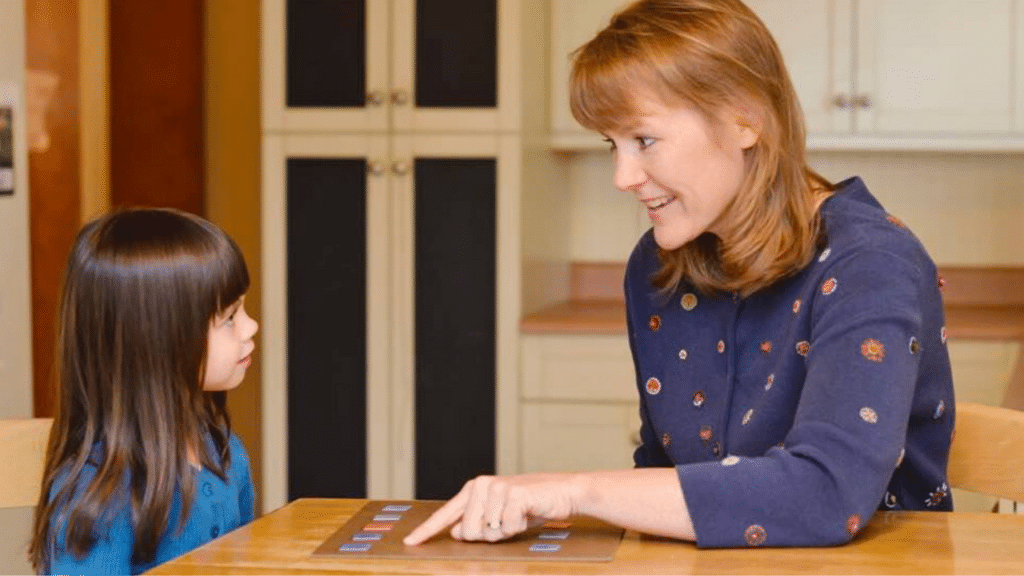
How can one not start at the beginning, you may be wondering. “Start” and “beginning” kinda mean the same thing, right?
In keeping with our mission here at Reading Simplified—streamlined instruction, accelerated achievement—I propose you skip the beginning stage of traditional reading instruction: teaching letter sounds in isolation.
Instead, jump to teaching letter sounds in context–in the context of real reading.
I wager with you: If you try the technique described below, your beginning readers will learn to read faster.

Typical Teaching of Letter Sounds
Imagine what happens every morning in most 4K, K or 1st grade classrooms in U.S. classes. Teachers are encouraged to hold up, point to, or highlight on their SMART board a letter and teach its name and often its sound. Perhaps several letters will be reviewed. The letters may be contextualized into real words, ideally in a multi-sensory way, yet the focus of the lesson will be on the letter alone, as in
p
and, at best, on its position in the beginning of a word:
pickle
puppy
purple
paper
Most curricula and teachers assume that before a child can learn to read, she has to learn the letter names and their sounds.
THEN real reading can start.
Is that true?
Is that the most efficient plan?
Our experience working with hundreds of beginning and struggling readers says,
“No.”
How to Teach Letter Sounds from the Beginning
Instead of teaching letter names or letter sounds in isolation first, we guide both beginners and struggling readers how to build one word at a time using manipulatives–first. Yes, even if they do not yet know the letter names or sounds.
Here are some of the steps of Build It that allows the teacher to skip past letter names in isolation:
Destinee, what do you hear in this spot in the word, ‘ssssssssat’?
Yes, that’s right this sound (tapping space) in “sssssat” is /s–/.
Do you know which of these (tapping letter-sounds) is /s–/?
Even if Destinee has never had formal reading instruction, she has a 1 in 3 chance of getting the teacher’s question right.
Multiple choice is easier.
It’s one way to scaffold her learning. Suppose she doesn’t know which letter is /s/. The teacher can simply say,
No, this (tapping the “s” tile/square) is /s–/, as in the word, “ssssat.”
Then Destinee will move the “s” square into the first line and the teacher will repeat her questioning cycle:
Great! Now listen for the sound you hear in this spot (tapping 2nd spot), when I say, /sssa—–t/ (exaggerating and elongating the short “a” sound).
What sound do you hear?
Yes, that’s right this sound (tapping space) in “ssssaaaat” is /a–/.
Do you know which of these (tapping letter-sounds) is /a–/?
Yes! Pull down the /a—/ and say it as you move it.
Now the task is getting easier and easier. The teacher can ask Destinee to finish building the word, “sat.”
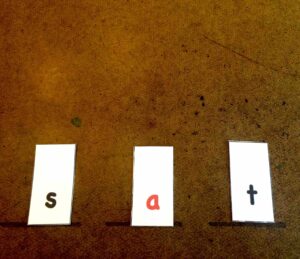
She ends by saying each sound separately (phonemic segmentation) as she points to each: /sss/ /a–/ /t/.
The same coaching through the word can continue with Destinee or with a handful of students in small group instruction. These students will be learning the letter-sounds in a multi-sensory way, but that’s not all!
They will also be learning these other fundamental skills:
- How our written language code works (the alphabetic principle)
- How to segment words into phonemes (individual sounds)
- Left-to-write scanning (a concept about print)
This simultaneous integration of multiple beginning skills makes the instructional time much more efficient. See our previous blog post, “Integrate, Don’t Isolate” for more about the benefits of integrating multiple skills.
And, yet, I don’t find that this approach simply reduces instructional time.
More importantly, this approach, which we call Build It, moves directly toward a real literacy behavior—spelling real words. Since it’s more like real reading, it makes more sense to young learners, especially those who would otherwise struggle with reading.
Teaching any new skill in the natural context in which it occurs is usually more effective for learning’s sake.
Watch this beginning 4 year-old as she tries to build the word, “sad.” Notice all the reading sub-skills she is putting all together in the context of a meaningful word simultaneously
Teach Letter-Sounds in Context
Imagine a tennis instructor who begins the first several weeks of instruction by simply showing and practicing how to toss the ball for a serve.
What if he modeled how it related to serving himself (as in when a teacher reads “p” words), but he doesn’t ever allow the beginner to try to serve?
Yes, practicing a toss in isolation at times may be beneficial, but to begin tennis instruction with just that in isolation will delay many future players.
How high should they toss it?
How will they know if it’s a good toss?
Without a system for getting feedback, this approach at learning how to serve or how to begin in tennis, will be very inefficient. And those players who have seen little or no real tennis before will be especially
“at-risk”
of getting little or nothing out of the experience of tossing a ball in the air over and over again. All of that info about the experience may even be “filed” away in the their brains in the wrong place because the isolated activity has little or nothing to do with the relevant context of tennis.
So goes beginning reading instruction as well.
Teach letter-sounds in the context of real words for spelling and reading and children will more likely:
- Learn the letter-sounds more quickly,
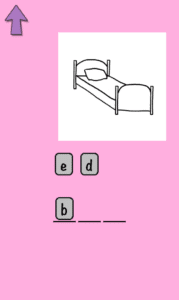
- Store the information about the letter-sounds in the part of the brain most connected to reading, and
- Not miss completely the point of the teacher’s instruction!
Skip the traditional beginning weeks or months of reading instruction and jump right into Build It. However, since this technique is so counter-cultural, you may have doubts….You may doubt whether your K or 1st grade students with limited literacy exposure could handle such a big jump.
You may be surprised to discover that traditional Montessori classrooms have been guiding their 3 and 4 year-old students to begin reading and writing instruction this way for over 100 years–in the context of real words and sentences. Somehow I never learned about the Montessori techniques when I earned my master's in education. Thankfully, my mother-in-law tuned me into it when her first grandchild (yes, my first-born daughter) needed to find a good pre-school. What a difference that approach made to our daughter's ease of learning to read!
In case you still doubt, here's an example of an advanced 3 year-old doing an activity much like our Build It.
If you're wondering what the theoretical or research communities have to say about the value of teaching letter-sounds, phonemic awareness, and reading all together, here are some biggies:
- The National Reading Panel concluded in its Phonemic Awareness meta-analysis that phonemic awareness instruction combined with decoding was more powerful than phonemic awareness instruction without letters.
- Some researchers have tested the isolation vs. integration question directly. An early study on this by Peter Hatcher, Charles Hulme, and Andrew Ellis can be found here. Briefly: reading + phonemic awareness instruction > than either phonemic awareness or reading instruction alone.
- A past president of the International Literacy Association and chair of the National Early Literacy Panel, Tim Shanahan, indicates here that the National Reading Panel “concluded that phonemic awareness and phonics both needed to be taught and that they could and should clearly be connected.”
- The ultra-scholarly among us can read deeply into the theory undergirding the Build It approach with Dr. David Share's “self-teaching hypothesis.”
Please try Build It with a beginning student! And please let me know what questions or concerns you have before trying this approach.
Or, if you have tried it, were there any sticking points?

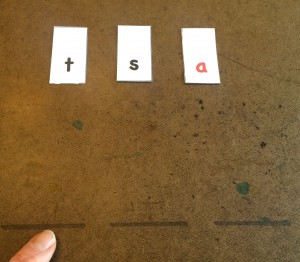
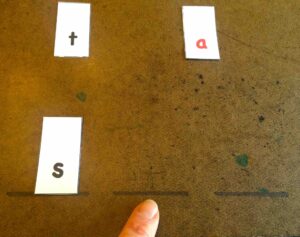
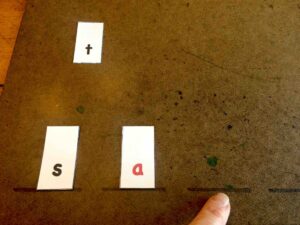

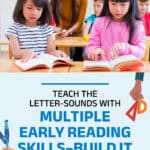
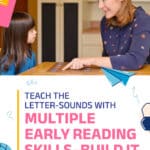

Well you certainly flipped the traditional model on its head. I like it. I have always assumed that you would start at the very beginning.
I have a niece that is learning to read and write now. Her mother is a kindergarten teacher so she would be very open to this approach or at least be willing to try.
Ha! Glad the flipped model appeals, Shae.
It’s so much fun (usually) when teachers get to teach their own children to read. Hope it goes well for them!
Another truly remarkable post! I love how you make it so simple. My daughter was lucky to attend a Montessori preschool last year and started her reading journey with the techniques you described. As she is now 5 and no longer at that pre-school, I am attempting to continue to build upon her skills at home. She knows her letter sounds well and has mastered the three letter words, but I am not sure where to go from here and how to tie in the sight words. She is never keen to practice at home. Any ideas ? Should we be doing reading books? games? writing? Thank you for sharing.
Kimya, glad to see you here again! Thank you for the kind words. Yes, please do continue to build on her good foundation by reading words and books. Switch It is a game that I describe here along with word lists: https://readingsimplified.com/integrate-dont-isolate. It will help develop her decoding flexibility “mental muscles” and is usually considered fun for 5 min. Also, letter-sound cards to do Switch It are found here: https://readingsimplified.com/childs-worldview/
Also, the Read It activity that you already read about is an important activity, too. Try to move her into CVCC (i.e., “help” or “must”) and later CCVC words (“flag” or “stop”). If she doesn’t want to sit and do one word at a time with you, you could play a game I call Act It Out. Put individual words on a index cards; have her draw a card; read it; and then act it out a la charades style. Example words for her: hop, rest, jump, fast, swim, spit 😉 etc. If she has the patience to write each word as she says each sound afterwards, great! If not, wait to do that later. (Another idea: you could also write words on post its and place them in funny places around the house. Go on a hunt!)
Sight words develop best when the child has strong sound-symbol relationships and strong decoding skills (like the flexibility that will develop in Switch It) and THEN she re-reads the same texts multiple times. To motivate, you could create simple books for her with her name in it and include high frequency words and easily decodable CVC and CVCC words, such as “Leslie will jump…..She will run….Leslie is running.” Or you could go to this site for personalized free options: http://www.bookbuilderonline.com
Finally, easily decodable texts that she reads with your support and then re-reads several times would be the last step in moving her towards willingness to practice reading with you. Here are some places to find such texts:
http://www.progressivephonics.com/phonics-books/beginner-phonics-books (free but uses word families so mix with other types);
Bob books by Bobby Maslen (also good apps with same name);
Nora Gaydos “Now I’m Reading” Level 1 books
starfall.com Go to the Learn to Read section (they also sell their books for little)
Apps are great ways to sneak in practice, too. Montessori Crosswords is one of my favorite. I also list my top 7 picks in the sidebar of my blog.
Hope this sounds doable! I know it’s a lot of info.
Wow! As a Kindergarten teacher and mom of a curious 4 y/o boy, this response has answered SO MANY of my wonderings! We use Wilson’s Fundations in my district, which I have found good success with, but need “something else” for my kiddos who struggle to get anything to stick.
So, I’m hearing:
-Start with Build It
-Progress to Switch It
-Move to Read It
-Then practice in context (thanks for the resources!!! Beginning phonics/decidable are sooooooo hard to find!)
Summer vaca just began for us here in CT, but I’m already looking forward to beginning my new year with this knowledge! Thank you so much Marnie!
Perfect interpretation, Jess. Sorry I didn’t see this earlier. Hope you’ve got a good plan now for the new year! 🙂
My daughter is 6 and in a Spanish immersion program in kindergarten. I was wondering how learning to read in Spanish would impact her ability to read English words and while I’m not sure what exact methods are being used at school (it’s a combination of “starting at the beginning” and learning in context), she is able to apply the concepts in both languages. It helps that we read a lot too – I usually read a book first, and then I make her read it back to me. She relies on her memory, the pictures, as well as the actual words to get through the book 🙂
Now I’m curious to try your techniques out with my three year old.
Rosanna, good question! How wonderful for her to be in a language immersion program! I’m jealous. Usually, the research indicates that on average children learning 2 languages will be slower at first but end up with far greater cognitive and educational achievements.
Learning the phonemic (individual sound-based) structure of 2 written languages will develop the cognitive flexibility that’s especially needed to decode words in English (Spanish having a code that’s more 1-to-1 is so much easier). I would recommend the activity Switch It, which I write about here, along with a video: https://readingsimplified.com/integrate-dont-isolate/
Switch integrates multiple reading skills, such as phonemic awareness, letter-sound knowledge, decoding, and flexibility. I might do a little of it with English and then separately a little in Spanish so she gets really good at distinguishing the English short vowel sounds from the Spanish vowel sounds.
Your current reading relationship sounds awesome! I would keep that going and gradually wean her off you reading everything. Example: Today, ask her to read one word in the book that you’re reading aloud. Then tomorrow ask her to read one word a page. At what ever rate she can handle the transition based on her motivation, just gradually move from doing the work to having her do the work. Sounds like she’s doing well so don’t feel as if you have to rush the transition; I just wanted you to be headed in that general direction for 1st grade.
Also, the Read It activity is essential to ensure that she does what I can Blend As You Read: https://readingsimplified.com/one-and-done-nearly/
If you do 5-10 minutes a day of these things several times a week, she will likely learn to read well regardless of the approach of her school. (See above comment for example books if you need easily decodable book examples.)
What do you do for whole class teaching of the letters and sounds?
Tami, great question! I generally prefer to teach all reading sub-skills, such as letter-sound knowledge, in small groups. Each group will get better instructional match that way and they’ll progress more rapidly.
However, if that’s not your preference or is not feasible, I would still do Build It as described in this post. Students would take turns moving the letter-sounds into position on the interactive whiteboard, regular whiteboard/chalkboard, or on overhead projector. Kids would take turns moving individual letter-sounds.
When a child comes to the front of the room and moves the letter-sound into place, I would ask the whole class to speak aloud that sound at the same time.
They could also have their own letter-sound cards at their desk and move letter sound along with the one on the board.
In addition, while Build It would be my main approach to ensure they get a strong foundation in sound-symbol processing, a little reinforcement in isolation won’t hurt. I might sing the alphabet song but say the letter-sounds instead of the letter names, for instance. 🙂 Try it–it sounds funny but you get the hang of it quickly. Or, if they watch a letter-sound video/song like Leap Frog’s Letter Factory. Again, these would reinforce the letter sounds and not names. But these activities in isolation are only secondary to the more meaningful, contextual activity of Build It. Let me know if I’m not addressing your question!
Thank you so much. You answered my question. My principal wants me to move away from teaching 2 letters a week and I am looking for alternatives.
Excellent! Thanks for letting me know, Tami. I look forward to hearing how it goes!
I have just discovered your amazing website and blog – thank you!! My question is….do we work through the ‘Build It’ Wordlists in a particular order? I am assuming we start in the very left hand column and work down to the bottom before moving to the next column of words? Sorry if that is a weird question!
Great question! Not weird at all. 😉
Thanks for the kinds words, too. 🙂
When I plan my lessons for this level of reader, I think about 2 main goals:
1) Phonemic awareness: How well are they segmenting each sound in CVC words?
2) Letter-Sound knowledge: Which consonants are they learning? Which short vowels are they learning?
So, if they can segment CVC words and know more than 5 letter-sounds, they are advancing beyond the need for Build It and I would replace it with Switch It instead (which does the same things as Build It but challenges them more deeply so they learn faster).
Or, if they are NOT able to segment CVC words yet, we’ll stay with the Build It activity.
Then, the 2nd goal kicks in for planning purposes–do they know letter-sounds in a given column about 70% of the time?
If so, I move to the next column–always adding as many consonants, and especially short vowels, as they can handle each day. That’s one way we save time; we’re always adding a new letter-sound (at least) each day. I try not to camp out with just the same-old short vowels day after day.
So typically developing readers won’t do all of the words in any column and won’t even do all the columns because they’ll move on to Switch It after they know a handful of letter-sounds and can mostly segment CVC words.
The lists are long to provide a wider selection of words and to support children with learning challenges. In sum, move across the page, from column to column, as aggressively as possible. You may worry that your students can’t handle it, but give it a try! They also may surprise you. The main problem I see with K teachers teaching these skills is that they move too slowly adding letter-sound knowledge and phonemic difficulty.
Hope this makes sense!
I had the privilege of attending your Letter of the Day session at the IRC reading conference in Peoria last week. You’ve inspired me to do more with my phonics time!
Is there a spot to download the letter cards?
Thanks for your help
Jodie Landers
Hi Jodie! It was so great to meet you! A great question.
Here’s where you can find a letter-sound cards template:
https://readingsimplified.com/childs-worldview/
Please let me know how these activities work for your kiddos!
I need help with how this looks at the start of the year in my K/1 class of 19? I love the academy but feel lost for how to start the year teaching the sounds in small groups. How many in each?? I’ve done 3 kids in each group but it feels overwhelming…6 groups to meet with each day? Help!!❤️
Hi Robbie! Yes, I understand the struggles! I have a blog post that addresses this exact concern over small group reading. Check it out here for tips and techniques: https://readingsimplified.com/small-group-guided-reading-structure
I hope this helps serve your readers!
Marnie
Thank you for such good and easy to follow instructions.
I teach in an early
intervention class. Assortrd levels and ages.
Could you please help me with any ideas on how i can implement this in my class.
Thank you.
Hello Sandra!
Thank you for your comment! We show teachers and parents how just a small handful of activities can rapidly accelerate all beginning and struggling readers’ decoding. You can learn more about our core techniques in 1 of two ways: 1) You can read about these core activities on our blog here: ReadingSimplified.com/start-here OR, 2) You can watch an on-demand workshop, 3 Activities a Day to Keep Reading Difficulties Away, when it’s convenient for you. Register for a time for this workshop here: ReadingSimplified.com/event
Hope this helps!
Marnie
Good evening Mam Marnie,…I am a grade two teacher and I found out that most of my pupils have difficulty reading cvc words. I came to read and like your ‘reading simplified” fb page. I believe that it will be of great help to my pupils. May I be permitted to use your strategy/technique which is the “Build It” followed by “Switch It’ in doing my action research for my non-readers? Thank you very much . I’m looking forward for your positive response.
Hi Lydia, yes, of course! Please try any of the activities that you find on our Reading Simplified website. It’s an honor that you’ll try it!
Another activity that will help with reading CVC words is Read It, which you can learn about here.
This just looks like phonographix to me.
Indeed, Phono-Graphix was invaluable for me in learning how to teach reading! Build It is our variation of what I believe P-G called “Word Construction.” And I believe their activity Word Construction has roots in Montessori’s Movable Alphabet, which she began at the turn of the 20th century.
Even though I tutor third and fourth graders who have dyslexia tendencies, I have a few students who really struggle with decoding. I use a version of Switch It with them, but they still struggle. Build It is exactly what I need to help them. We are on summer break right now, but I can’t wait to use this method when we return to school in a few weeks.
May it serve your readers well!
Hi, I’m just discovering your wealth of knowledge and I’m so excited to dive deeper. I have previously taught 1st and 2nd but will begin teaching K in the coming year. I am looking into your Build It activities at the moment I thought I may practice with my 4 y/o son. My question is about letter names. You mentioned in this article we could begin the steps of Build It even if they do not yet know the letter names or sounds. I love and understand how this approach will tackle letter sounds in context but if they don’t know letter names when we “jump in” with Build It, when or how do the students develop their letter name knowledge? How do we work this into the Build It activities?
Thanks for your knowledge and time!
Thanks for your interest Katie! Good question. After students are reading and writing, it’s fairly easy for them to add the letter names. When literacy is a blur, learning the letter-sounds or letter names is harder. But, once they “get” reading then learning the letter names becomes a piece of cake–especially in the U.S. culture which is heavily letter name focused for early years’ children.
Marnie, your program sounds and looks great! I’ve been looking for something that would help me to be effective in such a short reading block time. This looks perfect! Do you offer the letter pieces that you use somewhere on your site? What other resources do you offer?
Thanks,
Juanita
Thanks so much for writing! You can snag a free PDF of our letter-sound cards here:
Readingsimplified.com/childs-worldview
We have loads of free samples on our site and you can begin exploring here: ReadingSimplified.com/start-here
Have you ever done your “3 Activities a Day” routine whole class? I know small group is most effective, but on a half day schedule, teachers are having a hard time making small groups happen and we have such big learning loss at the moment.
Also, do you have a suggested sequence in the 3 activities? Do you focus on one activity at a time for a few weeks, or try and incorporate all 3 activities in each day?
Yes, some teachers do our system whole group. And you can find our scope and sequence here.
I would like to teach this to my 4 and 5 year old grandchildren. It makes such good sense to me. I am a retired first grade teacher.
Marnie, I have a question. So if you are working with struggling students and you have them build sat. Should you have them build word families of -at? Or move onto another word such as dog? In the world of learning to read how important are word families in teaching?
Another question, I have a reader and this child really has trouble with mixing up vowel sounds. Using the envelope idea would be helpful???
We generally avoid word families in the early stages of learning how to read so the child learns how the code really works. It’s organized by individual phonemes and we want them to see/hear that “at” is composed of “a” and “t.”
For those who mix up the vowel sounds, the best activity is Switch It. The game with the envelope word reading could also help!
So, let’s say that we have worked with a child for awhile when do you start putting them text and not just words?
We start reading real texts from the first lesson. We call it Buddy Reading if the child can’t do much real reading on her own.
Each lesson consists of Re-Reading for Fluency, a selection of Word Work activities, like Build It, and Guided Oral Reading of a new text.
How do you help children who don’t know how to write their letters. Is this taught in the program?
We support children’s handwriting, supplementally, via Word Work activities. We also suggest a 1 min. alphabet drill that we learned from EBLI. And we recommend Peterson handwriting prompts when there’s no other handwriting program already available.
Oh how I wish I had found this information before kindergarton was almost over and the teacher might possibly reccomend holding back my son, which his father is absolutely adamant that we are going to do. It happened to him as a child and he said it really killed his self esteem, so he is completely against it. However, my son doesn’t remember or understand almost anything that has to do with academics.
I am eager to try build it, to see if it will help him. But the only problem is, he doesn’t remember how letters sound, no matter how many times we go over them. For example he has a list of 6 sight words he has to learn and he has a few memorized but the last two words are had and all, and no matter how many times I try to get him to sound it out, not only can he not do it, but he can’t remember what sound an h makes no matter how many times i tell him.
So tonight I just went straight through the alphabet and had him tell me each sound that the letter makes, and he did for all except for two or three letters, so he DOES know them if i seperate them and in the context of the order of the alphabet, so why does he not know them every time I ask him what an h sounds like when Im trying to help him read the word had?!
Also, my son has a speech articulation disorder, so making the different sounds has always been a challenge for him. We assumed he was having a hard time with written language partly because of that, but I just cant get anything to stick! He also wont pay attention to the words when I try to get him to read them. I am willing and ready to try build it but im not sure if he will be able to remember the sounds to put words together or if he will just forget everytime.
He is like this with pratically every subject in school where he will not pay attention at home or retain anything. It’s like he wont take in the info.
For example, and I know this is a different subject, but just to explain further what I mean, he had a math sheet assignment for homework where they had to create a math equation.
I already knew that he doesn’t know what a math equation means or how to read it, but I explained it many times to him. I tried to make it as understandable as I could and teach him that equations are just the way we read math symbols.
I could get him to understand the math problem, like he understands the numbers and concepts of having a certain number of something and then giving a certain number away or adding more to it. But he could not understand the symbols in a math equation. (They also had a pretty complicated word problem about having a certain number and subtracting 1 in the first sequence and subtracting one more than you had previously in the next sequence) Again, not reading, but I don’t know if I ever got the information to him.
He comes home all of the time with unfinished schoolwork or incorrectly done schoolwork, which my mom assumes he got wrong because he couldn’t read the directions, so I don’t know if he is understanding any information he’s supposed to be learning in school.
Have you had experiences with similar cases where children couldn’t remember anything, and you were still able to teach them through your methods? Any advice on helping him to focus when I try to teach him at home?
Thank you so much for your website, information, and free resources you’ve supplied already!
Thank you for sharing your experience. It’s clear that you’re deeply invested in supporting your son, and that’s so important! The activities we recommend are designed to make the code clear and explicit, which can be especially helpful for students with complex learning needs. Because our approach keeps things simple—focusing on just a few powerful activities—many students experience success with reduced cognitive load.
Since Reading Simplified is primarily a professional development program for any adult supporting any reader, we teach a system of strong activities and diagnostic decision-making, which allows flexibility to meet a variety of needs. Our Teachers’ Lounge is an online discussion board where Dr. Marnie Ginsberg and other experts provide guidance every weekday, so there’s plenty of support to help you tailor the activities to your son’s situation.
In general, once a student knows about 5–7 letter sounds, they’re actually ready for Switch It rather than Build It, though starting with Build It for a short time can work, too. You know your child best! Just be prepared to move into Switch It soon. https://readingsimplified.com/why-phonics-isnt-sticking/
Since you mentioned ongoing challenges with memory for basic skills, you might also consider reaching out to your child’s school about an educational evaluation. This can help ensure he gets the right support across the school day. Here’s a helpful guide on how to make that request: Understood.org.
Wishing you and your son all the best on this journey! And jump into the Reading Simplified Academy if you think we’re a good fit!
I tried this tonight, and it was no different than any other time or thing ive tried to teach him. Its like he literally has no clue of whatever im asking of him. One of the words he needs to know is had, so i started with the first sound. no matter how i said the word he just couldnt tell me that the sound matched the letter h.
he kept saying a, no matter how many times we went over it.
i also dont feel like im getting his full attention no matter how hard i try so hes not getting anything.
how do i help him?
I hear how hard you’re working to support your son, and I know how frustrating it can be when progress isn’t coming as expected. Please know that you’re not alone—some kids need extra support, more diagnostic decision-making, and more repetitions to make those early connections.
If he’s consistently struggling to connect sounds with letters, it may help to step back and focus on hearing and distinguishing sounds first, before attaching letters to them. Games that build his ability to notice and play with sounds can sometimes be a helpful bridge. You can learn more at https://readingsimplified.com/prek/.
It also sounds like his learning needs may require additional diagnostic and learning support beyond what’s possible in a quick exchange here. Feel free to email us at admin@readingsimplified.com, and we can learn more about you and your child and decide if the Reading Simplified Academy would be a good next step for supporting you and your son.